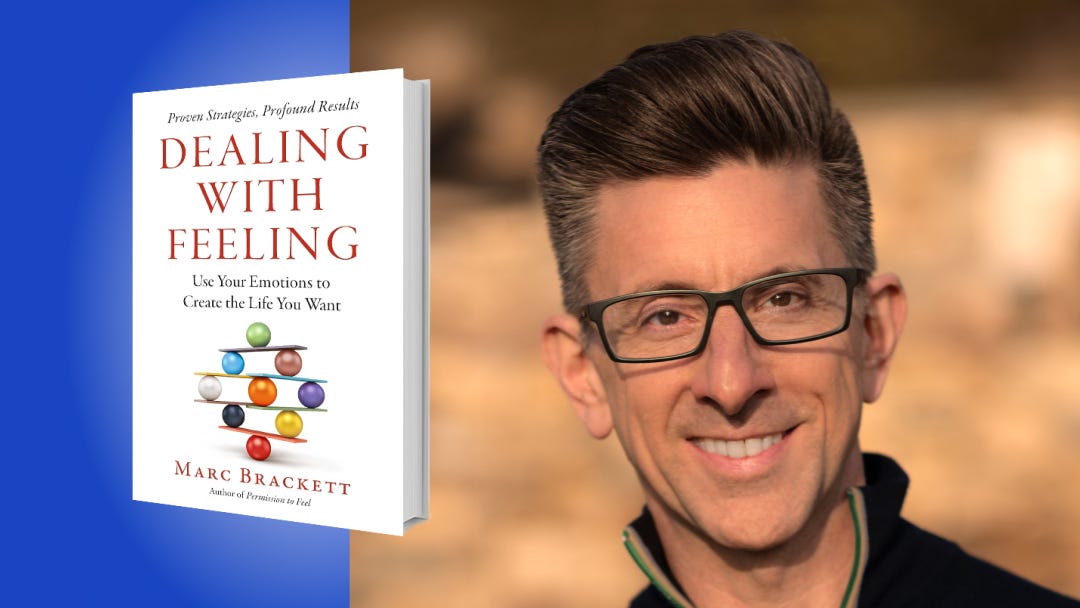How Are You Feeling?: The Hidden Logic of Your Emotions
Why understanding what you feel—and how you manage it—may be the single most important skill for success at work and happiness in life.
Listen now on Spotify or Apple Podcasts:
What are emotions? They more or less run your life—pushing and pulling you from one mind-state to the next all day long. Yet their true nature remains mysterious. Are they physical sensations in the body? Ancient instincts? Brief glitches in our otherwise rational minds? Marc Brackett has spent his career chasing that mystery—and what he’s found is that emotions aren’t enemies to suppress or distractions to ignore. They’re signals—powerful ones—that can help us live, work, and connect more wisely. Marc is the founding director of the Yale Center for Emotional Intelligence, and in his new book, Dealing with Feeling: Use Your Emotions to Create the Life You Want, he shows us how to turn emotional confusion into clarity. Get a copy on Amazon and read on for five of Marc’s big ideas:
1. We need to give ourselves permission to feel.
Most of us grew up hearing things like:
“Stop crying.”
“Don’t be so sensitive.”
“Shake it off.”
And so, we learned—explicitly or implicitly—that emotions are problems to avoid, not signals to explore. But ignoring or suppressing emotions can lead to anxiety, chronic stress, headaches, digestive issues, sleep disturbances, and even long-term impacts on physical and mental health. It also makes it harder to connect with others and regulate emotions effectively.
Giving yourself permission to feel means embracing all emotions with curiosity, not judgment. It means saying to yourself: “This is how I feel right now, and it’s okay to feel this way. Let me understand it.” That moment of acknowledgment is the gateway to healing, growth, and making wiser decisions. Emotions are not weaknesses. They are data.
When we approach emotions with empathy—for ourselves and others—we create the conditions for insight and resilience. The challenge is that only a third of people report having “permission to feel” when they were young. What will make us all feel that we have permission to feel?
2. Emotion regulation is 100 percent learned.
Where did you learn how to manage emotions? Was it through watching your parents? Was it from teachers? Friends? Maybe no one ever taught you directly, but you still learned. We all did.
Ask yourself, on a scale from one to five, how much emotional education you received growing up. And how much of that education helped you develop effective regulation strategies? My research shows that only about 10 percent of people feel as if they had a solid education in emotion regulation.
Common default strategies (especially in moments of stress) include avoidance, yelling, eating, scrolling, numbing, blaming others, or blaming yourself. These are not character flaws. They are just what you learned. But the good news is that because emotion regulation is learned, it can also be relearned.
“My research shows that only about 10 percent of people feel as if they had a solid education in emotion regulation.”
You can upgrade your emotional regulation strategies to include techniques such as deep breathing, accurately labeling emotions, practicing positive self-talk, reframing situations, or seeking support. These are teachable, learnable, and they work. But they require intention, practice, and sometimes unlearning what no longer serves you.
This week, Book of the Day is brought to you by Robert Glazer, an award-winning CEO, and #1 Wall Street Journal bestselling author of The Compass Within: A Little Story About The Values That Guide Us. Robert is also the author of a weekly leadership focused newsletter which delivers valuable leadership lessons in the form of inspiring storytelling and real-world leadership experience. Join a community of over 112,000 leaders dedicated to getting a little better each week by signing up for Friday Forward today.
3. Breathing is necessary but not sufficient.
Breathing is a powerful tool, and I teach it to everyone, from kindergartners to CEOs. Conscious breathing activates the parasympathetic nervous system, helping us move from the fight-or-flight response to the rest-and-digest state. It deactivates our stress response and creates space for wiser choices. That’s why I call it the “master strategy.”
But breathing is only the beginning. The real transformation happens after breath. Once you’ve calmed your body, what do you do with your mind? What story do you tell yourself? What action do you take? Breathing helps you press pause, but it doesn’t solve the problem. That takes reflection, strategy, and sometimes courage.
The other day, I visited a middle school classroom and asked a student what he’d do if someone were mean or hurtful to him. He said, “Take a deep breath.” I replied, “That’s great, but what’s next?” He couldn’t answer. Breath is only the bridge that takes you to the side where real emotion regulation work can begin.
4. You are what you think.
When you make a mistake, what’s the first thing you say to yourself? Do you call yourself an idiot, or do you say, “Hey, everyone messes up. It’s okay. I’ll apologize, learn from it, and move on.” That inner voice shapes everything from your emotional state to your behavior to your sense of self-worth. And that voice can be trained. Two of the most powerful strategies are positive self-talk and reappraisal.
Positive self-talk isn’t about pretending everything is fine. It’s about being kind and encouraging to yourself, especially in tough moments. It’s even more effective when spoken in the second or third person: “Marc, take a breath. You’ve got this.” That subtle shift—called psychological distancing—helps us regulate better by stepping back from the heat of the moment.
Reappraisal, or reframing, means choosing a new lens through which to view a situation. It’s the difference between “This is a disaster” and “This is a challenge I can learn from.” I like to say: reframe instead of blame.
“That inner voice shapes everything from your emotional state to your behavior to your sense of self-worth.”
For instance, I tend to repeat myself a lot during keynote presentations. There are days when I say to myself, “Really, Marc, this is what you are going to do for the rest of your life?” But I know better than to go on stage with that mindset. So, I reappraise. Recently, I gave a big talk at a tech company, and I switched my internal dialogue to, “Marc, you are going to present your life’s work to over 1,000 engineers, managers, and leaders. Think about the impact you can have on their personal and professional lives.” With that mindset, I gave one of my best talks!
5. Focus on other people.
When we’re anxious, angry, or overwhelmed, the instinct is often to withdraw, ruminate, isolate, or spiral inward. But research tells us that reaching out to support others who are suffering is a helpful strategy for healing not only them, but us too.
This is a form of co-regulation. When we help others manage their difficult emotions, we simultaneously help regulate our own. Parents do this with their children all the time, but it’s just as relevant in friendships, workplaces, and partnerships.
When you show up for someone else with empathy, patience, and presence, then you also create connection. You model emotional intelligence, and your kindness has the potential for ripple effects. Even witnessing someone else being emotionally supportive can inspire others to do the same.
Next time you’re feeling low, ask: Who else might be struggling? And how can I help—even in a small way? You might find that helping someone else is the most effective way to help yourself.




